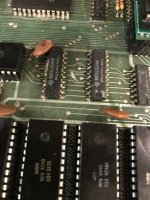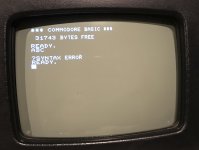daver2
10k Member
So, I was just reviewing the thread again to get a bit of inspiration.
If you run the ROMulator with the ROM and RAM mapped internally - this still requires the video circuitry and I/O devices (e.g. PIA and VIA) for the PET to work.
Thus is where we are having the problem I believe.
Going back to post #63, we appear to have working external RAM and video circuitry (it passes the tests).
We appear to have a faulty ROM - but that shouldn't affect us - unless the ROM is affecting the data bus in some way.
Now, the thing that has grabbed my attention is the $82 value that is displayed for each of the keyboard bytes.
This indicates that either:
1. The keyboard PIA wasn't installed, so the value is just random. However it is a non-random random value!
2. The entire keyboard matrix is returning the same byte value. This is possible with a fault in the key matrix.
3. The other interesting possibility is that this is giving us a glimps of the fault.
Dave
If you run the ROMulator with the ROM and RAM mapped internally - this still requires the video circuitry and I/O devices (e.g. PIA and VIA) for the PET to work.
Thus is where we are having the problem I believe.
Going back to post #63, we appear to have working external RAM and video circuitry (it passes the tests).
We appear to have a faulty ROM - but that shouldn't affect us - unless the ROM is affecting the data bus in some way.
Now, the thing that has grabbed my attention is the $82 value that is displayed for each of the keyboard bytes.
This indicates that either:
1. The keyboard PIA wasn't installed, so the value is just random. However it is a non-random random value!
2. The entire keyboard matrix is returning the same byte value. This is possible with a fault in the key matrix.
3. The other interesting possibility is that this is giving us a glimps of the fault.
Dave


